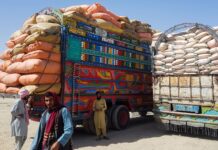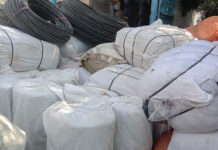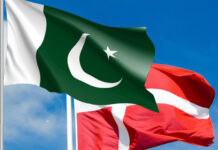South Asia has experienced a surprisingly cool March in 2023, with Pakistan in particular experiencing lower than average temperatures in the in-between summer and winter season. Despite this, many experts are warning that Pakistan and the rest of the region could still be under threat from climate change driven heat waves that will have catastrophic effects on the country’s agriculture and living conditions.
“Despite the anomalously cooler March in Pakistan in 2023, we might still experience a heatwave that could rival last year’s,” Hassan Aftab, an expert in Earth Sciences, said on Twitter. “Last year, 50% of people in Jacobabad fled the city and things did not return to normal until 4 months later,” he added.
On the 13th of March 2023, the Pakistan Meteorological Department (PMD) issued a warning that the country is likely to experience higher than usual temperatures during the upcoming summer season. In fact, an intense heat wave was predicted for the time between March and May.
According to PMD, the heat’s intensity will rise beyond its normal levels due to the less rainfall expected for this duration. A 77% decrease in rainfall was reported for the month of February, which meant that the average day and night temperatures were higher than normal by 3 to 5 degrees Celsius. Consequently, higher temperatures are expected not only for March but also April and May.
Previously, the average temperature in March was recorded to be around 26 degrees Celcisus. A slight increase was observed last year, but the temperatures are expected to be even higher this year- with warnings of an imminent heat wave.
The expected heatwave is not only limited to Pakistan. India is also bracing itself for an intense summer, as the India Meteorological Department (IMD) forecasted an “enhanced probability” of heat waves between March and May.
According to the IMD, “above normal maximum temperatures are likely over most parts of northeast India, east and central India and some parts of northwest India from March to May.”
India also experienced above-average temperatures this winter season, with its hottest February in well over a century.
Cause for the Heat
Experts are highlighting La Nina as a cause for the heat, which refers to the periodic cooling of ocean surface temperatures in the central and east-central equatorial Pacific that affects global weather patterns.
“The summer of 2023 is a disaster in the making that will feature an unprecedented heat wave due to a weak western disturbance and the prevailing La Nina condition,” Abinash Mohanty, sector head of climate change and sustainability at IPE-Global, an international development organisation, told DW.
According to Mohanty, climatological and meteorological conditions combined with unsustainable human activities have caused harsher heatwaves, which also severely affect food chains.
A report launched earlier this week by the Intergovernmental Panel on Climate Change (IPCC) indicated that despite progress in policies and legislation around climate change since 2014, it’s still highly likely that global warming will exceed 1.5 C during the 21st century.
However, Akshay Deoras- a meteorologist at the UK’s National Centre for Atmospheric Science and the Department of Meteorology, disagrees. According to him, early heat waves are not necessarily precursors to more frequent and intense heat waves.
“Given models have a varying prediction skill, we cannot be sure right now about the enhanced probability of heat waves this season. It is important to remember that the frequency, intensity, and duration of potential individual heat waves in a season cannot be predicted,” added Deoras.
How do heat waves affect the economy?
According to a DW article by Murali Krishan, the main problem of a heatwave is the threat of crop damage. The maximum temperature in some wheat-growing areas such as Rajasthan soared above 39 degrees Celsius (102 degrees Fahrenheit) earlier this month, nearly 7 C (12.6 F) above normal, according to IMD data.
Scientists and meteorologists assert that changes in temperature and rainfall in India will add to the current water stress in the country. More importantly, premature rains could damage winter-sown crops — such as wheat, rapeseed and chickpeas — just before harvesting begins. “If temperatures continue to rise and monsoon rainfall patterns continue to change, the country could see a GDP loss of 2.8%, depressing the living standards of nearly half its population by 2050,” according to a World Bank report in 2018.
Sounding a dire warning, the report said that over half of South Asia’s population lives in vulnerable areas and is susceptible to declining living standards, which can be attributed to dwindling agricultural yields, lower labour productivity and related health impacts.
Pakistan’s economy is also deeply vulnerable to the climate crisis. Heat waves are termed the “silent disaster” as heat-related deaths are often undercounted around the world, according to the World Weather Attribution Network.
Judging by recent years, it is increasingly clear that both India and Pakistan are among the most vulnerable countries when it comes to climate change. Experts argue that the country’s early warning system needs to become more robust.
What can we do?
The PMD advised people to take necessary precautions to avoid heat-related illnesses and stay hydrated during the summer season. It also urged the government to take necessary measures to mitigate the effects of the heat wave and minimise its impact on the population. As Pakistan braces itself for the upcoming summer season, it’s crucial for authorities and citizens alike to remain careful and take necessary steps to protect themselves from the anticipated extreme temperatures.
Insofar as the agricultural produce is concerned, Mohanty emphasised the need to make agri-food systems heat stress ready, followed by a fast-tracked renewable energy development across the heat wave spots.

























Heat waves can have significant impacts on the economy, particularly in agricultural-dependent countries like India and Pakistan. The effects of heat waves on the economy are primarily driven by the threat of crop damage, which can lead to reduced agricultural yields and disrupt the livelihoods of farmers.